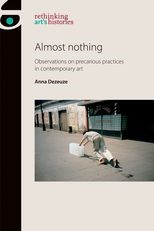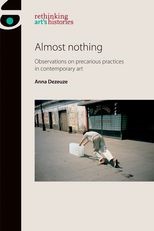Almost Nothing: Observations on precarious practices in contemporary art
Almost Nothing: Observations on precarious practices in contemporary art
Lecturer in Art History
Cite
Abstract
This book proposes a new reading of contemporary art between 1958 and 2009 by sketching out a trajectory of ‘precarious’ art practices. Such practices risk being dismissed as ‘almost nothing’ because they look like trash about to be thrown out, because they present objects and events that are so commonplace as to be confused with our ordinary surroundings, or because they are fleeting gestures that vanish into the fabric of everyday life. What is the status of such fragile, nearly invisible, artworks? In what ways do they engage with the precarious modes of existence that have emerged and evolved in the socio-economic context of an increasingly globalised capitalism? Works discussed in this study range from Allan Kaprow’s assemblages and happenings, Fluxus event scores and Hélio Oiticica’s wearable Parangolé capes in the 1960s, to Thomas Hirschhorn’s sprawling environments and participatory projects, Francis Alÿs’s filmed performances and Gabriel Orozco’s objects and photographs in the 1990s. Significant similarities among these different practices will be drawn out, while crucial shifts will be outlined in the evolution of this trajectory from the early 1960s to the turn of the twenty-first century. This book will give students and amateurs of contemporary art and culture new insights into the radical specificities of these practices, by situating them within an original set of historical and critical issues. In particular, this study addresses essential questions such as the art object’s ‘dematerialisation’, relations between art and everyday life, including the three fields of work, labour and action first outlined by Hannah Arendt in 1958.
-
Front Matter
-
Introduction: almost nothing
-
Part I ‘Dharma bums’, 1958–71
-
Part II The light years, 1991–2009
-
End Matter
Sign in
Personal account
- Sign in with email/username & password
- Get email alerts
- Save searches
- Purchase content
- Activate your purchase/trial code
Institutional access
-
Sign in through your institution
- Sign in with a library card Sign in with username/password Recommend to your librarian
Institutional account management
Sign in as administratorPurchase
Our books are available by subscription or purchase to libraries and institutions.
Purchasing information| Month: | Total Views: |
|---|---|
| October 2022 | 1 |
| October 2022 | 1 |
| October 2022 | 8 |
| October 2022 | 1 |
| November 2022 | 1 |
| November 2022 | 2 |
| November 2022 | 1 |
| November 2022 | 1 |
| December 2022 | 1 |
| December 2022 | 1 |
| December 2022 | 2 |
| January 2023 | 2 |
| January 2023 | 1 |
| January 2023 | 1 |
| April 2023 | 1 |
| May 2023 | 4 |
| May 2023 | 2 |
| May 2023 | 1 |
| July 2023 | 2 |
| July 2023 | 1 |
| September 2023 | 3 |
| September 2023 | 4 |
| October 2023 | 6 |
| October 2023 | 7 |
| October 2023 | 3 |
| October 2023 | 1 |
| November 2023 | 2 |
| December 2023 | 1 |
| December 2023 | 2 |
| January 2024 | 6 |
| January 2024 | 3 |
| January 2024 | 4 |
| January 2024 | 3 |
| January 2024 | 2 |
| January 2024 | 2 |
| January 2024 | 3 |
| January 2024 | 2 |
| January 2024 | 4 |
| January 2024 | 1 |
| January 2024 | 3 |
| January 2024 | 3 |
| February 2024 | 1 |
| February 2024 | 3 |
| February 2024 | 5 |
| March 2024 | 1 |
| March 2024 | 2 |




Get help with access
Institutional access
Access to content on Oxford Academic is often provided through institutional subscriptions and purchases. If you are a member of an institution with an active account, you may be able to access content in one of the following ways:
IP based access
Typically, access is provided across an institutional network to a range of IP addresses. This authentication occurs automatically, and it is not possible to sign out of an IP authenticated account.
Sign in through your institution
Choose this option to get remote access when outside your institution. Shibboleth/Open Athens technology is used to provide single sign-on between your institution’s website and Oxford Academic.
If your institution is not listed or you cannot sign in to your institution’s website, please contact your librarian or administrator.
Sign in with a library card
Enter your library card number to sign in. If you cannot sign in, please contact your librarian.
Society Members
Society member access to a journal is achieved in one of the following ways:
Sign in through society site
Many societies offer single sign-on between the society website and Oxford Academic. If you see ‘Sign in through society site’ in the sign in pane within a journal:
If you do not have a society account or have forgotten your username or password, please contact your society.
Sign in using a personal account
Some societies use Oxford Academic personal accounts to provide access to their members. See below.
Personal account
A personal account can be used to get email alerts, save searches, purchase content, and activate subscriptions.
Some societies use Oxford Academic personal accounts to provide access to their members.
Viewing your signed in accounts
Click the account icon in the top right to:
Signed in but can't access content
Oxford Academic is home to a wide variety of products. The institutional subscription may not cover the content that you are trying to access. If you believe you should have access to that content, please contact your librarian.
Institutional account management
For librarians and administrators, your personal account also provides access to institutional account management. Here you will find options to view and activate subscriptions, manage institutional settings and access options, access usage statistics, and more.